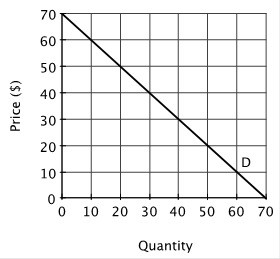Refer to the accompanying figure, which shows the annual domestic supply and annual domestic demand for jeans in a small country. Suppose this country initially does not trade with the rest of the world. If the world price of a pair of jeans is $40, and this country opens itself to trade, then the annual domestic production of jeans will:
Suppose this country initially does not trade with the rest of the world. If the world price of a pair of jeans is $40, and this country opens itself to trade, then the annual domestic production of jeans will:
A. increase from 20,000 to 28,000.
B. increase from 4,000 to 28,000.
C. fall from 20,000 to 4,000.
D. fall from 28,000 to 4,000.
Answer: C
You might also like to view...
Suppose a monopolist faces the demand curve shown below.  The monopolist maximizes its profits by:
The monopolist maximizes its profits by:
A. producing 35 units, since this is where total revenue is maximized. B. charging $70 for each unit. C. producing the level of output at which marginal revenue equals marginal cost. D. producing the level of output at which marginal revenue minus marginal cost is greatest.
In terms of the competing claims of equality and efficiency, in the United States we have
a. chosen greater wage inequality for lower unemployment. b. chosen higher unemployment for less wage inequality. c. both greater wage inequality and higher unemployment. d. not faced a trade-off between wage inequality and unemployment. e. been able to choose both less wage inequality and lower unemployment.
Refer to the following graph. The maximum amount of good A can be consumed in this economy without trade is
The maximum amount of good A can be consumed in this economy without trade is
A. Q units. B. F units. C. P units. D. G units.
Public Broadcasting, in its fund drives, often appeals to viewers by saying, "without you, there will be no Big Bird." This is likely to ________ the free-rider problem and lead to a ________ level of contribution to the public good.
A. increase; smaller B. increase; larger C. reduce; smaller D. reduce; larger